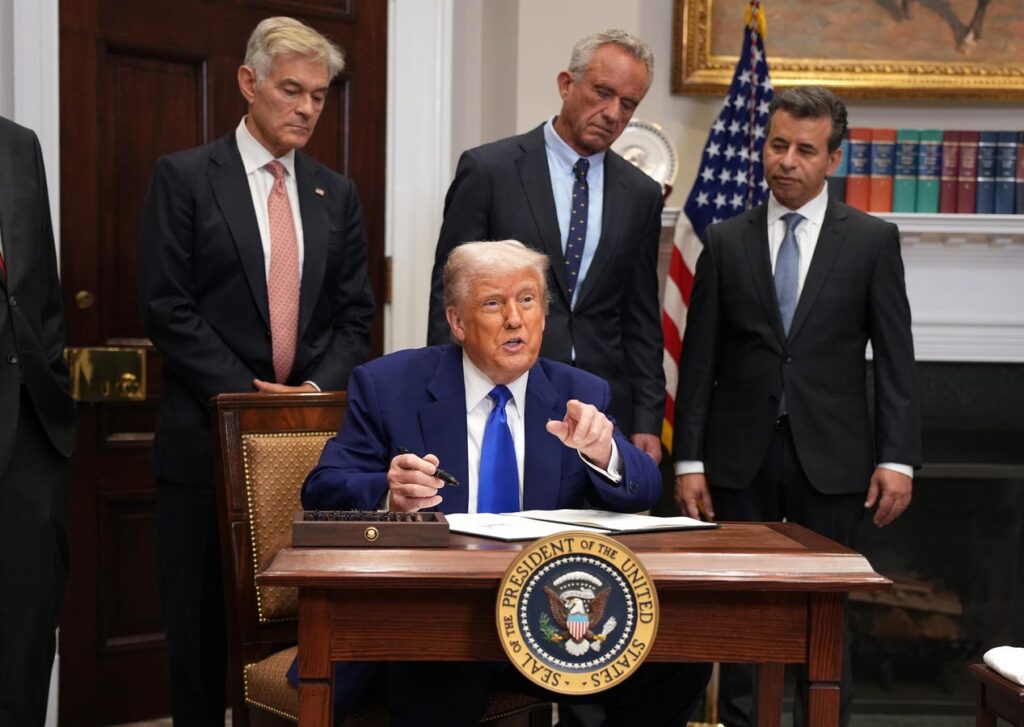President Donald Trump’s executive order aimed at lowering the prices of prescription drugs in the U.S. is unlikely to reduce them very much at all. While Trump made his announcement with great fanfare, he has little or no power to make the changes he promises.
Trump’s idea, which is similar to a plan he failed to enact in his first term, would tie drug prices in the U.S. to prices paid in other countries, which almost always are lower than in the U.S. He seems to want to force other countries to pay more for medicine so consumers in the U.S. could pay less. He insists his plan, which would apply to Medicare, Medicaid, and private insurance, would lower U.S. prices by up to 90%.
While Trump is trying to tap into the frustration of U.S. consumers over the high cost of drugs, he will struggle to turn his rhetoric into reality. One reason: As with tariffs, he is trying to achieve multiple goals that are inconsistent with one another.
What Could Trump Do?
One indicator of how hard it will be for Trump to achieve his cost-cutting goal: While share prices in pharmaceutical companies initially fell on the news of Trump’s executive order, they then rose substantially. The May 12 headline in the Economic Times said it all: US Pharma Stocks Gain Up To 5% On Trump’s Move To Slash Drug Prices.
In most developed countries drug prices are negotiated by their public insurance programs. And while Trump wants the U.S. to set “fair market prices” in other countries, he has no authority over those decisions.
He could try to use other tools, such as tariffs, to try to force countries to raise their drug prices. But as we’ve seen in recent months, import taxes generally are the economic equivalent of shooting oneself in one’s foot. Trump himself has been backtracking on aggressive tariffs in the face of growing criticism in the U.S.
Conflicting Goals
And there is yet another problem. Trump says his goal is to lower U.S. drug prices. But if he is going to tie U.S. prices to foreign prices and use U.S. influence to force those prices higher, he’ll end up increasing U.S. costs compared to a lower foreign benchmark.
That trade-off may benefit drugmakers, but it won’t help consumers. And it may be evidence that the goal of Trump’s executive order is not to get U.S. consumers the lowest possible prices at all. His idea of “most-favored prices” may only be to make sure U.S. costs are lower than in other countries, not the lowest possible.
In addition, Trump likely has no legal authority to unilaterally set prices through what is known as “reference pricing.” He was blocked by the courts when he tried this in his first term, Reuters noted, and he could run into the same problem now. Such price-setting must be done with congressional approval, not unilaterally by the president.
Trump appears to be aware of this problem. He tried to convince House Speaker Mike Johnson (R-La.) to include presidential authority to fix prices in the omnibus budget bill working its way through Congress. But the usually compliant Johnson reportedly turned Trump down, per Politico, once the Speaker realized the idea had little support among Republicans. GOP senators are equally skeptical, The Hill reports.
Finally, even if Trump could somehow impose such price targets, drugmakers would likely find ways to avoid them.
Biden’s Plan
Of course, the U.S. already has a program in place to reduce drug prices. In 2022, President Joe Biden and Congress allowed the Centers for Medicare and Medicaid Services to negotiate prices for a handful of costly drugs.
Under that authority, CMS lowered prices for 10 drugs. For example, the monthly price for the diabetes drug Januvia will drop from $527 to $113, starting next year. And another 15 drugs, including Ozempic and Wegovy, are in line for price cuts starting in 2027, if Trump does not kill the program.
While many conservatives decry drug negotiations as government price fixing, many economists see it merely as a large buyer using its purchasing power to manage costs, not unlike what any business does (and what, in fact, private insurance does).
Biden’s effort has the virtues of being relatively simple and probably legal (although Pharma has challenged it in court).
But Trump often is anxious to undo Biden initiatives, and his desire to put his own mark on a plan to lower drug costs drove him to renew a version of his first term plan.
There is only one explicit action in Trump’s executive order, a call for the administration to “communicate most-favored-nation price targets to pharmaceutical manufacturers” within 30 days.
Beyond that, there is little more than a commitment to take unspecified steps if drug companies and foreign governments do not comply with Trump’s vague demands.
Unfortunately, there is little to his idea beyond promises. And users of pharmaceutical drugs are unlikely to see material price changes as a result.
Read the full article here

